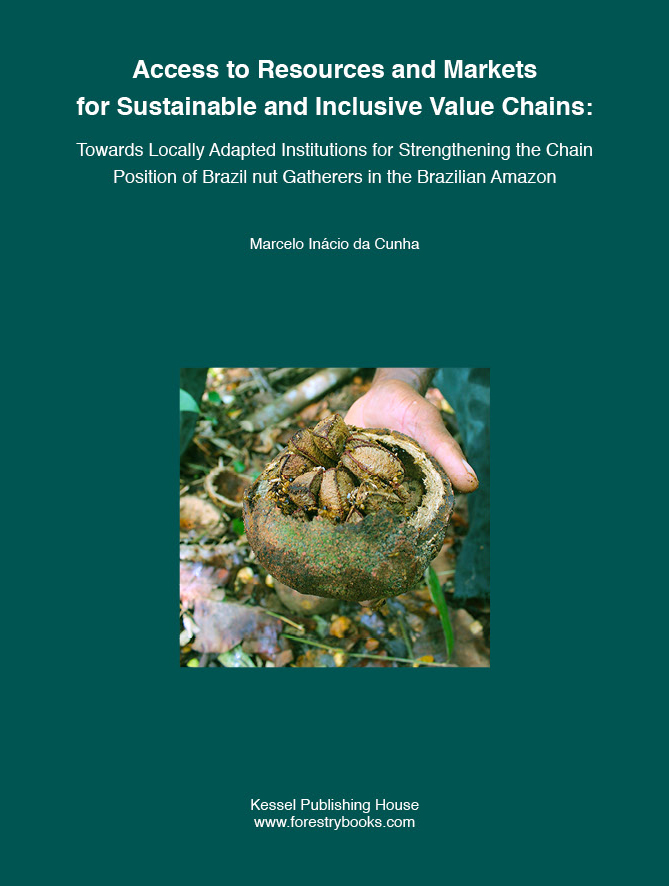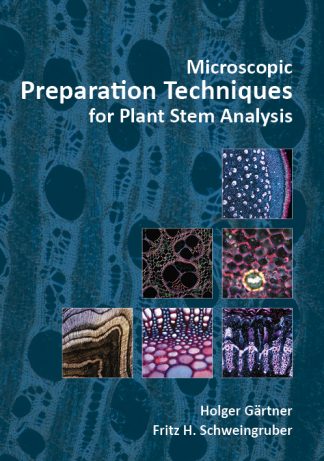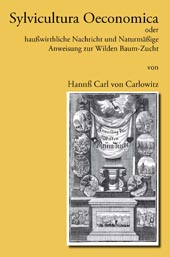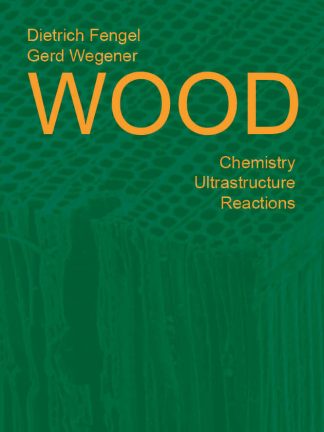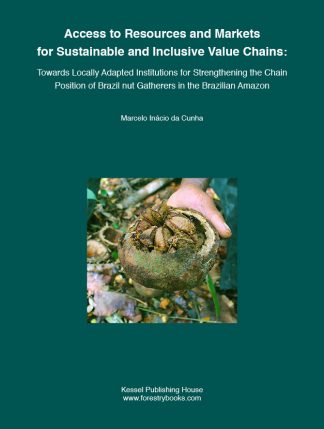Beschreibung
Given the lack of access of forest
dependent rural dwellers to resources and markets as well as the lack of
an institutional environment that is conducive for reconciling
biodiversity conservation and livelihood strategies in the Brazilian
Amazon, the main and sub-research questions are respectively:
How do informal and formal institutions affect the
access to Brazil nuts and markets by buyers and, especially, by
gatherers within the Brazil nut value chain in the Lower Amazon basin?
How are institutions – that affect resource and market access – institutionalized and formalized?
By identifying self-declared informal and formal
institutions filtering resource and market access of upstream value
chain actors, it is scoped for leverage points towards locally adapted
institutions to overcome such access limitations in the realm of
strengthening Brazil nut gatherers’ chain position.
The following institutions in use have been found to be
crucial for determining the (lack of) access to livelihood relevant
resources (Brazil nuts) and markets in the Lower Amazon basin. The
informal institution analyzed is the debt-peonage system aviamento and
the formal one is the ‘Term of Compromise’ (TdC, per acronyms in
Portuguese) in Brazil. The TdC is a legally-based instrument for
overcoming conflicts between the Chico Mendes Institute for Biodiversity
Conservation (ICMBio, per acronyms in Portuguese) – as responsible
branch of the Brazilian Ministry of Environment (MMA, per acronyms in
Portuguese) for managing federal Protected Areas (PAs) – and traditional
populations over natural resources in such areas.
The innovative analytical framework developed herein
captures how both informal and formal institutions (determinants) as
well as related formalization and institutionalization (processes)
affect the resource and market access by upstream value chain actors.
This framework helps capturing institution-based access restrictions
affecting the chain position of Brazil nut gatherers (corresponding to
the main research question). It builds the groundwork for constructing a
model to help understand what is behind empirical phenomena pertaining
to the institutionalization and formalization of access limiting
institutions (corresponding to the sub-research question herein). The
proposed ‘model on analytical ingredients for self-sustained
strengthening of upstream value chain nodes’ is built for transforming
locally reported institution-based access problems towards the outcome
of adapted access enabling institutions for strengthened upstream nodes
of food chains.
Quantitative and, particularly, qualitative data were
collected from ‘community’ to national level (2012–2015). In order to
quantify socioeconomic conditions and resource as well as market access,
a survey was conducted with 185 households in four municipalities of
the Lower Amazon region. Detailed qualitative data was gathered mainly
through narrative, problem-centered and key-informant interviews with
the already quantitatively assessed households accounting for a
respective sample of 89 actors in two of these municipalities (Oriximiná
and Óbidos): mainly the ones directly involved in upstream nodes of the
Brazil nut value chain (Brazil nut gatherers and buyers) yet also
indirectly involved actors at all administrative levels, including
representatives of the Brazilian government (e.g. from ICMBio, from MMA,
from the Ministry of Agrarian Development (SEAD (formerly, MDA), per
acronyms in Portuguese), the Ministry of Development, Industry and Trade
(MDIC, per acronyms in Portuguese)); from the private sector (including
all three Brazil nut processing mills in the subnational region at
stake) as well as from NGOs (e.g. from the Amazon Institute of People
and the Environment (IMAZON, per acronyms in Portuguese), from the
Institute for the Management and Certification of Forests and
Agriculture (IMAFLORA, per acronyms in Portuguese), and from the
Pro-Indigenous People Commission of the state of São Paulo (CPI-SP, per
acronyms in Portuguese).
Results including leverage points for strengthening the
chain position of economically and geographically marginalized value
chain actors on a sustainable basis show: (i) formalization of resource
and market access restrictions per TdC has reinforced unbalanced
patron-client relations among Brazil nut gatherers and buyers already
institutionalized per debt-peonage; (ii) self-reliant sustainable Brazil
nut value chain development depends on democratic participation in
decision-making for locally adapted TdC by transforming the governance
structures of councils for managing PAs from ‘consultative’ to
‘deliberative’ ones, while co-shaping a conducive context-sensitive
institutional environment, policies and service provision; (iii)
‘socioeconomic upgrading’ of the position of upstream value chain actors
builds on ability and self-organization of smallholders in
‘well-managed’ cooperatives (complying to widespread cooperative
principles).
Further, suggestions for actions and policy
recommendations based on analytical and empirical evidences are provided
– for each one of the actors directly or indirectly involved in the
Brazil nut value chain at stake – as are future research ‘needs’ in the
realm of self-determined local environmentally sound development. All
together, this thesis offers scientific input for an outcome pathway
towards an enabling institutional environment in the realm of inclusive
sustainable rural development.
Finally, this thesis’ contribution lies mainly in an
innovative problem-based and institution-sensitive approach to analyzing
(the lack of) resource and market access towards strengthening the
value chain position of marginalized upstream chain actors. The herewith
developed model and, particularly, analytical framework can be applied
for inclusive sustainable value chain development of agricultural and,
especially, non-timber forest products (NTFPs) in different rural
contexts.
